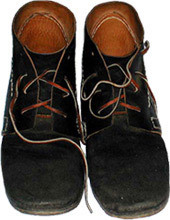
I am continually amazed how some myths throughout history keep resurfacing. No matter how many times they are disproved or doubted, they remain in our historical consciousness. George Washington chopping down a cherry tree is one such prominent tall tale. As you can guess, the Battle of Gettysburg has an infinite amount of its own myths and misconceptions. Just recently, I came across this news article from a newspaper in New Zealand which spreads one of the oldest myths of the battle.
Gettysburg: The American Battle than need not have happenedAlthough this was most likely a daily trivia story in this newspaper, it begs the question, "Why has this myth of a shoe supply persisted?" Up until the recent construction of a Nike Shoe "Factory" at a local outlet, there never was such a shoe factory in Gettysburg. So, where did this story come from?Friday, 30 January 2009, The Gisborne Herald
In 1863, the apparently invincible Confederate army marched northwards with the intention of inflicting a crushing defeat on the Union Army, the effect of which would hopefully drive Abraham Lincoln from office.
A battalion of Southern soldiers, dissatisfied with the deteriorating condition of their footwear, was informed by a colleague, that there was a boot factory in a near-by town. Approaching the town they encountered a detachment of Union cavalry and a violent skirmish ensued.
The Confederate army led by the unstoppable Robert E. Lee arrived as did the Union army commanded by General George Meade. The town was called Gettysburg.
The engagement lasted three days and ended with the failure of Pickett's Charge. Surrounding fields were strewn with over 50,000 dead or wounded, clad in either blue or grey. The great Confederate general had finally been stopped.
As neither Lee nor Meade originally intended to fight at Gettysburg a hypothetical question could be advanced. Was the decisive battle of the Civil War fought over the right of secession, the abolition of slavery, or just over pairs of boots?
Allan Colbert
Many historians argue that Confederate Gen. Henry Heth concocted this story as an excuse to hide his own errors leading up to the battle. Heth had been ordered by Lee not to bring on a fight, at least until the army was forced together. Heth did the exact opposite when he moved his entire division towards Gettysburg. Rather than finding shoes, the southerners found Union Gen. John Buford's cavalry awaiting them. Henry Heth argued that he was only seeking shoes for his footsore boys and he didn't mean to start this fight. If this were true, why did he take an entire division just to confiscate some shoes?
For as much as I admire Heth and his colorful military record, I have a hard time believing his story. First of all, Confederate forces under John Gordon had already marched through Gettysburg on June 26, several days before the battle, and found no shoes. Although there were a dozen or so cobblers and cordwainers in town at that time, these businesses hardly would have had enough shoes to supply thousands of men. In fact, Gordon's men held the town for ransom, which included a demand for 1,500 shoes. They didn't find any. Further southern intelligence suggested that there was no evidence of shoes in the area. For as much as many needed footwear, they weren't going to find any in Gettysburg. In Mechanicsburg however, one shoe salesman had his entire stock raided and was left with nothing more than $4,000 in useless Confederate currency.
As the old saying goes, those who yell the loudest are heard the clearest. Perhaps Heth simply defended his actions better than his contemporary critics did in denouncing them. Regardless of this, the Gettysburg shoe myth has had historians rolling their eyes for a century or more. Maybe this story keeps coming up simply because it is an entertaining tale. "The greatest battle in the Western Hemisphere began over a pile of shoes." Now that sounds intriguing! Clearly, famed people such as Ken Burns thought so since he included this in his masterpiece The Civil War. I suppose that is when this myth really skyrocketed into American consciousness. I suppose, in the end, maybe this story has done more good than harm. After all, such human interest stories (whether true or not) are what draw people to Gettysburg time and time again. Those darn shoes...

Expect to hear this myth and many, many more when you work at Gettysburg this summer! I cannot tell you how many times I hear visitors saying that McClellan had 30,000 men in reserve at Antietam, "who never fired a shot," and other such persistent myths. At most, Mac had, maybe, 5,000 infantry and 5,000 cavalry in reserve, not "two entire corps." I would imagine, though, what you are going to hear the most will be. . ."if only Jackson was alive, the battle would have turned out much different."
ReplyDeleteHave fun!
John D. Hoptak
I homeschool my kids, and we recently studied the battle of Gettysburg. I'm ashamed to admit that I taught them (as I'd been told) about the shoe thing. I guess I know what we'll be covering on Monday.
ReplyDeleteThanks J!
No worries Kel! I too believed it for a while! It was not until I became an AVID reader of the battle that I discovered it's all a myth.
ReplyDeleteGlad you make history fun for your kids!
Jared